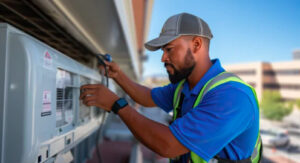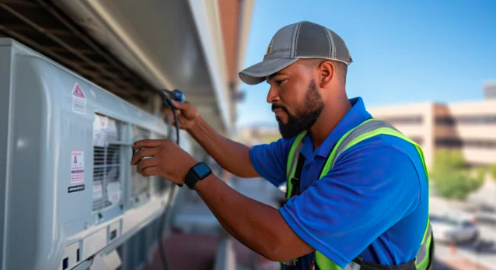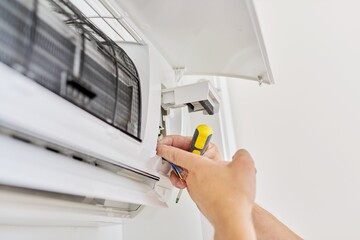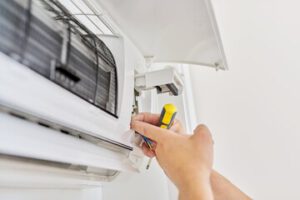 Heating, ventilation, and air conditioning (HVAC) systems manipulate environmental temperature to improve indoor comfort and air quality. They involve products like furnaces, air conditioners, and ductwork. Contact Hubbard Mechanical now.
Heating, ventilation, and air conditioning (HVAC) systems manipulate environmental temperature to improve indoor comfort and air quality. They involve products like furnaces, air conditioners, and ductwork. Contact Hubbard Mechanical now.
An HVAC system uses blower equipment to circulate cooled or warmed air throughout the home or office. It also filters and monitors humidity to prevent odors and bacterial growth.
Heat pumps are smarter, cleaner alternatives to traditional gas or electric furnaces. They heat, cool, dehumidify and filter air in your home. They can use your existing ducts or be installed as a ductless system for homes without ductwork. They are energy-efficient enough to earn the ENERGY STAR label, and can save you two to five times as much on your electricity bill as a typical electric heater.
They operate by circulating refrigerant to absorb and deliver the temperature you want in your house, using cycles of condensing and evaporating to transfer thermal energy. The process is very similar to that of a refrigerator, with the volatile fluid (typically called R-410A) passing through one or more heat exchangers. This process is controlled by a thermostat and a pump.
The evaporator, which is located in the indoor unit, usually consists of a coil or tubes. A fan blows air over the coil, which cools it and causes the refrigerant to evaporate within the tube or tubes. The refrigerant then returns to its saturated vapor state, and the cycle starts over again.
If your heat pump isn’t heating or cooling your home properly, there are a number of reasons it could be failing. Dirty air filters, closed registers or a clogged drain can cause issues, and only an HVAC professional can fix them. A clicking sound during operation can also indicate a problem with the compressor, and again, only an HVAC pro can replace it.
Heat pumps work in most US climates, even very cold ones, by exploiting the laws of thermodynamics. They move heat rather than generating it, and per unit of electricity are twice as efficient at delivering heat as conventional electric resistance heaters.
When your heat pump is in heating mode, the reversing valve opens and the volatile liquid inside the outdoor unit passes through a one-way valve to what’s known as an expansion valve. This lets the liquid vaporize, and as it does so, it picks up heat from the air outside your house. This heat is transferred into the evaporator coil, where it’s used to warm your home.
A furnace is a large heating appliance that warms air, water, or steam before distributing it throughout your home. It runs on liquid fuel, typically oil, although some use gas or even hydrogen. Furnaces can also run on electricity, although this requires special precautions to prevent fire and carbon monoxide issues.
A forced air furnace uses ductwork to distribute warm air to rooms in your house, which can be a benefit for those who have allergies or asthma, as well as those who want to lower energy usage and utility bills. However, it’s important to keep your ductwork clean, as dirt and debris can reduce your system’s efficiency.
When the thermostat detects that your home needs heat (the indoor temperature dips below a set point), it signals the furnace by turning on the ignition switch. This initiates the combustion process, which burns a combination of natural gas and air in the burner chamber. The hot flame then heats the metal tubing inside of the heat exchanger. The air in the supply and return ducts warms as it moves through the heat exchanger, and the blower fan directs the warmed air into various spaces in your home via ductwork.
The resulting exhaust gas from the combustion process is vented outside through a flue pipe. Your hvac technician can replace your furnace with a high-efficiency unit that produces fewer emissions and wastes less energy.
Other features in modern furnaces include a draft hood and blower motor to ensure steady air flow, an air filter to minimize allergens and odors, a heat sensor for early warning of potential problems, as well as safety features such as a rollout switch and a flame detector.
Furnaces should be kept away from flammable items, such as clothing and curtains, and the flame should always be blue. Any other color indicates a problem with the fuel or burner and should be addressed by a professional right away. You should also check your smoke and carbon monoxide detectors regularly and make sure you’re using a programmable thermostat to help lower your utility bills.
Air handlers are often paired with heat pumps or air conditioner condensers to form a complete HVAC system. They are like the “lungs” of your home, managing the flow of conditioned air and keeping you comfortable year-round. They work by sucking in ambient air, filtering it and passing it over an evaporator coil that absorbs or releases heat, depending on the season. This conditioned air is then circulated throughout your home via the ductwork, and dampers within the air handler control where airflow can be diverted to specific areas of your house.
There are different types of air handlers available to fit different needs, including single-stage, multi-stage and variable speed options. The type of air handler you choose should match the rating of your equipment so that both systems operate at the same capacity to ensure optimal performance and efficiency.
An air handler contains the indoor components of your HVAC system, and it can also be fitted with additional devices to improve ventilation and indoor air quality, such as electronic air filters, dehumidifiers or UV lights. They are powered by electricity, natural gas or a combination of both and may include an insulated cabinet, blower fan, drain pan, refrigerant coils and air filtration device.
The air handler’s main purpose is to regulate the temperature of the conditioned air it circulates throughout your home by mixing colder outside air with warmer inside air, and by adjusting the ratio between supply and return air. To do this, it must have a mixing chamber, dampers and a set of thermostats to monitor the desired temperature, humidity levels and airflow.
The air handler is the heart of your heating and cooling system, and the health of this essential component will impact the overall performance of your entire HVAC system. To keep your air handler working efficiently, you should maintain a clean environment and have it inspected annually by an HVAC professional to make sure all the internal parts are in good condition. Regular filter changes and a routine maintenance schedule will also help ensure your system performs at peak performance and reduce energy costs.
Ductwork is a network of pipes that transports warm or cooled air from your HVAC unit to the rooms and spaces of your home. Often, it’s hidden behind walls and ceilings. Fortunately, the proper installation and maintenance of ductwork helps to ensure that your heating or cooling system operates as efficiently as possible.
If your ductwork is in need of repair, you may notice one of two common symptoms: rattling sounds or whistling noises. These sounds are a result of air seeping out through loose or disconnected sections of your duct system. These problems can be very annoying, and they’re also a sign that your HVAC system is struggling to keep up with the amount of air it needs to properly heat or cool your home.
The most important thing to remember when it comes to your ductwork is that the proper size and routing of ducts are crucial for ensuring your home gets heated or cooled adequately. An HVAC professional will map out your ductwork design before installing it, and this helps to ensure that your entire home is matched up with the right sized ducts.
A ducted system typically has a plenum or main trunk line, and then individual ducts branch out from the plenum to the different rooms of your home. The ducts can be made out of sheet metal or flexible aluminum, and they’re usually insulated to keep the air in them from being lost to the outside.
There are a few different types of ducts, and each type has its own benefits and drawbacks. Sheet metal ducts are the most durable, and they’re usually constructed out of galvanized steel with a zinc coating that’s almost rustproof. They’re a great choice for areas of the house that are hard to reach, and they’re also quite cost effective.
The other common type of duct is the flexible aluminum duct. This is a lot lighter than the metal duct, and it’s very easy to install. However, it isn’t as durable and may be susceptible to mold contamination. It’s still a good choice for tight spaces where rigid metal ducts would be impossible to fit.



 Check the Air Filter
Check the Air Filter